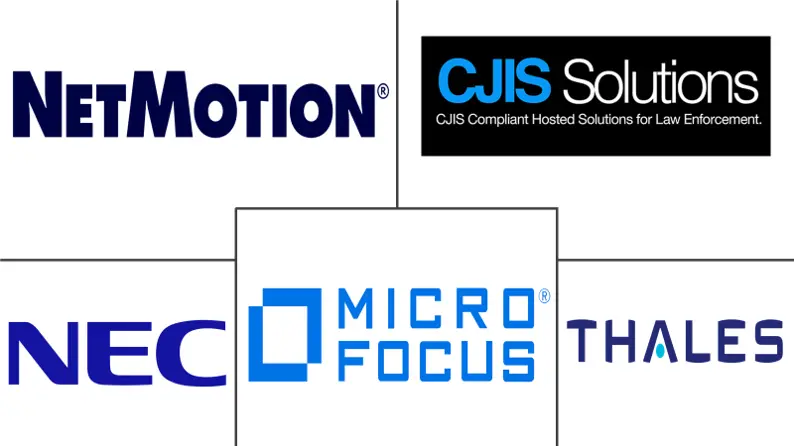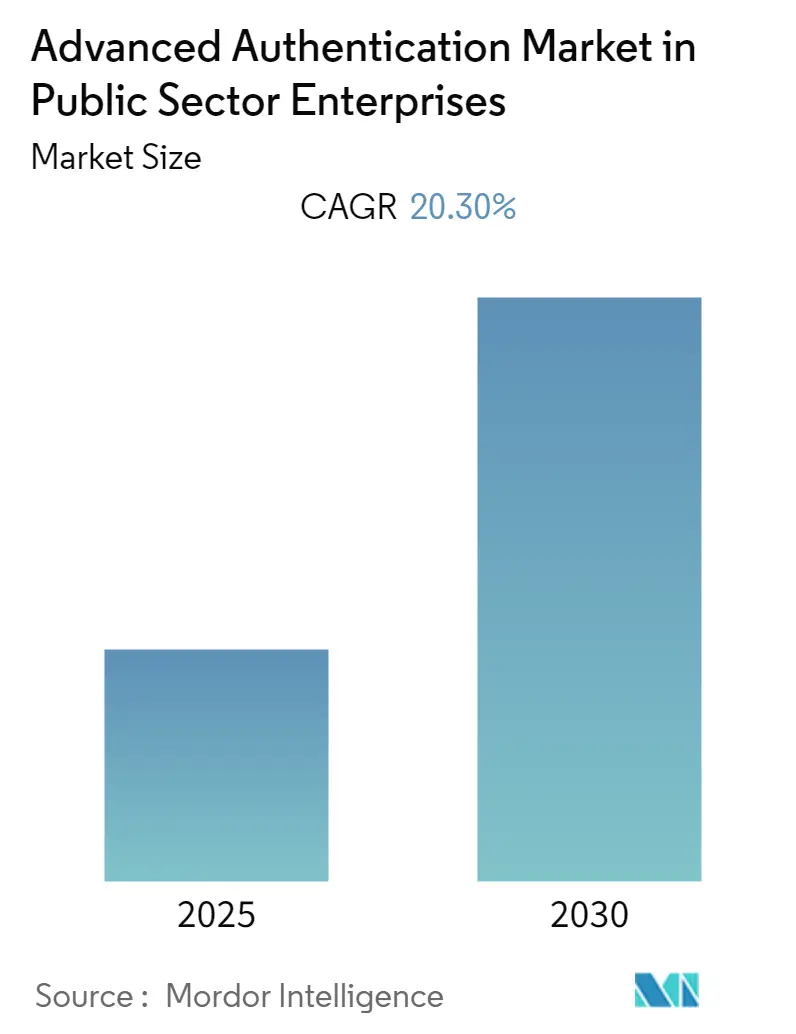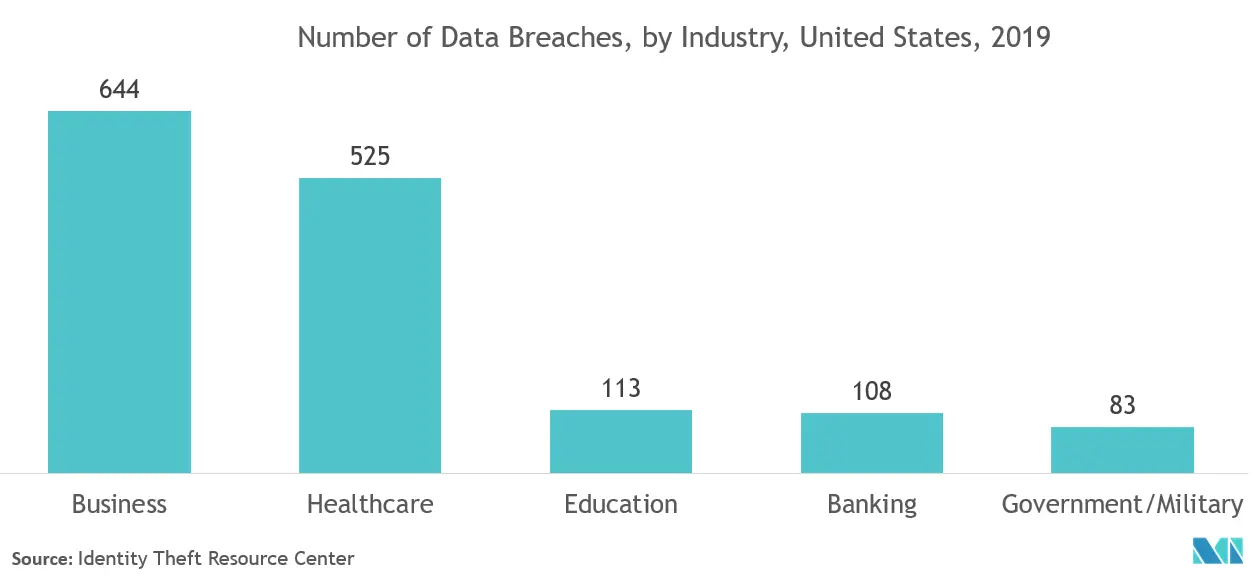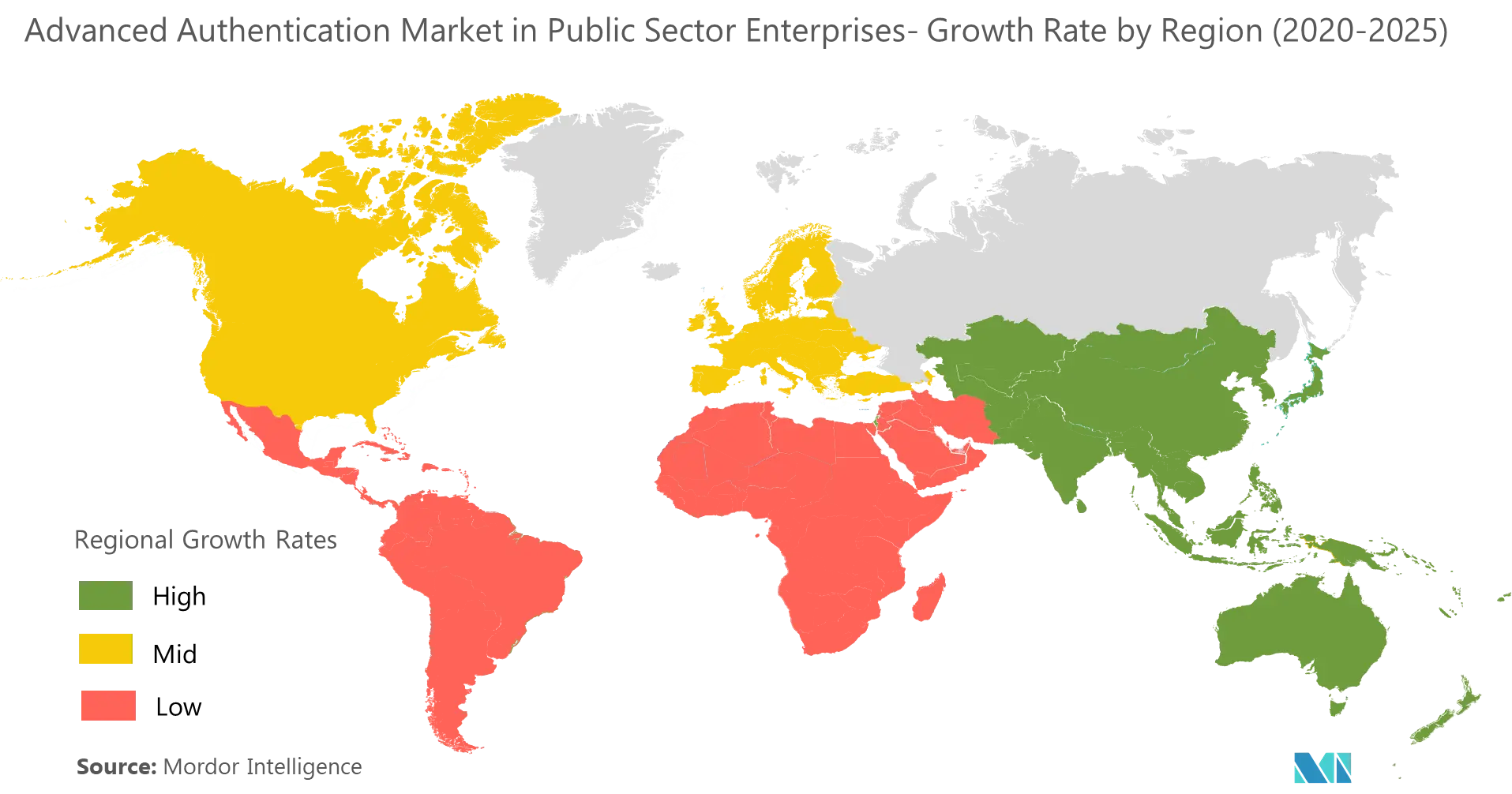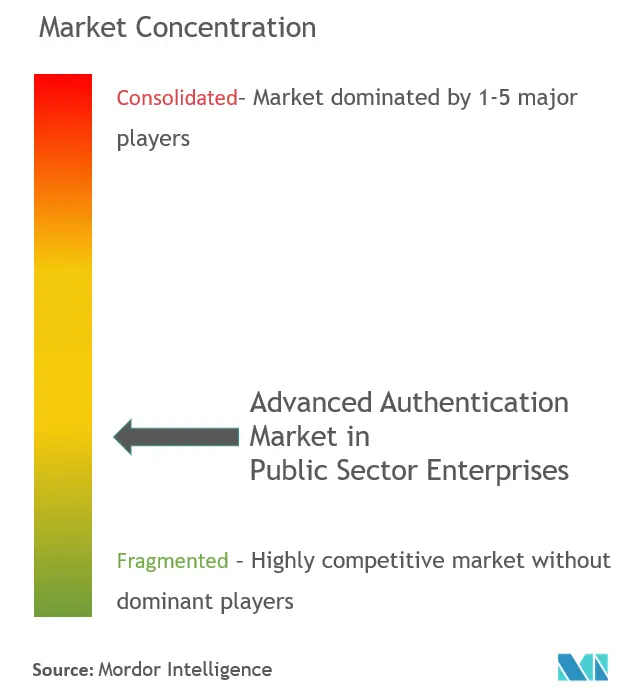Public Sector Enterprises Advanced Authentication Market Analysis
The Advanced Authentication Market in Public Sector Enterprises Industry is expected to register a CAGR of 20.3% during the forecast period.
- Verizon's latest Data Breach Investigations Report found that 16% of breaches were in the public sector, excluding healthcare. This is a slight increase in the 14% of incidents reported five years earlier. External actors have accounted for a growing percentage of breaches across all industries, making up 75% in 2019 against 62% in 2018. This suggests that although organizations are improving their defenses against insider threats and data loss protection, they face new and potentially more dangerous threats.
- Further, Verizon found that public sector cyber-attacks made up to 66% of all incidents in 2019. And 'state-affiliated bodies' have been the leading cause of external public sector data breaches since 2017. In 2019, they accounted for 79% of incidents. The information contained by these enterprises is most crucial, and typically have a record of the entire population of their region, making it one the favored sectors for the hackers. The hackers look to exploit the weaker security framework of these enterprises.
- Further, in other public areas, in February 2020, the government of Quebec has admitted to a data breach potentially impacting around 360,000 teachers employed in the Canadian province. By using a stolen username and password, the attackers were able to access a database where the information of teaching professionals was stored. Such instances indicate the demand for advanced authentication. Furthermore, the Ponemon Institute ranked public enterprises very low when it comes to monetary loss due to federal hacking agencies.
- In a recent trend survey made by DMEXCO and presented at an event in Cologne, Germany, it was determined that although the world is currently suffering economically, the digital economy may greatly benefit after the COVID -19 pandemic. According to the survey, the COVID -19 crisis will accelerate the rhythm of digital transformation and stimulate the demand for advanced authentication, mostly in the public infrastructure sector and government offices. Government organizations require robust authentication and encryption methods for secure access to online resources.
- In April 2020, responding to increased demand from government organizations needing to maintain productivity in a COVID -19 work from home environment, Authentic 8 announced the immediate availability of enhanced CAC/PIV card capabilities. Across the government and commercial sectors, end users are utilizing Silo to securely access OWA, O365, cloud storage, Time and Attendance services, ticketing systems, and more. The Silo Web Isolation Platform is in the process with FedRAMP certification and is deployed in production environments in more than 150 federal organizations to prevent a data breach.
Public Sector Enterprises Advanced Authentication Market Trends
Biometric is Expected to Hold Major Share
- With the increasing demand for cloud-based services, the authentication methods have increased significantly, where forms of MFA include a password combined with authentication apps, facial recognition, or fingerprint readers. Furthermore, the multifactor authentication market has received a significant push from the US government. The US defense also closed its USD 10 billion cloud contract in October 2019, where security is one of the critical parameters of the agreement, due to which multifactor authentication is going to play a vital role in the deployment of this project.
- Similarly, other enterprises have also been proactive in setting up new measures to prevent a data breach, which has resulted in more companies adopting multifactor authentication. For instance, in October 2019, the FBI warned about the vulnerabilities related to multifactor authentication. The FBI urged the public enterprises to integrate extra layers of biometric factors and behavior recognition checks to prevent hackers from efficiently bypassing multifactor authentication security systems.
- In the United Kingdom, in August 2019, Private biometric company Suprema supplies organizations including London’s Metropolitan Police and exposed a database that included more than one million fingerprints, user names, passwords, and facial recognition data. Suprema is the security company responsible for the web-based Biostar 2 biometrics lock system that allows centralized control. In July 2019, Suprema announced its Biostar 2 platform was integrated into another access control system – AEOS. AEOS is used by 5,700 organizations in 83 countries, including governments, banks, and the UK Metropolitan Police.
- The US federal government currently has an adoption rate of 93% of standard two-factor personal identity verification cards, according to a 2018 Office of Management and Budget analysis of cybersecurity across enterprises. Various new developments and innovations are being made to further secure multifactor authentication. For instance, in September 2019, BIO-key launched its biometric hardware and software authentication solutions that can fend off attackers and help ensure system protection. The company mentions its authentication solutions work unrestrictedly, with more than 30 fingerprint scanner models from different manufacturers.
North America is Expected to Hold Major Share
- Due to the recent development of the United States government, the North American region is expected to be a significant player in the market. On 28th January 2020, Federal CIO Suzette Kent mentioned that the U.S. government is implementing a zero-trust, and concepts, like advanced authentication through multifactor authentication, are crucial. Furthermore, the Ponemon Institute ranked public enterprises very low when it comes to monetary loss due to public hacking agencies. On 23rd January 2020, the U.S. government reported that at least five of the government's systems had malware planted by North Korea to access the vital information about the country. Instances like these would require the usage of robust advanced authentication systems in the region.
- The colossal data breach of government agency ever recorded was in 2015, when the data of 21.5 million people had swept away from the computers of government agencies in the United States. The U.S. government in 2019 reported that at least 98 attempts were made to hack the defense enterprises in 2019 alone. Further, SolarWinds' Federal Cybersecurity Survey, which covers the U.S. public sector, found that 52% of respondents identified foreign governments as the greatest threat, up from 34% five years ago. The hacking of government agencies has become primary propaganda too. For instance, on 5th January 2020, Iranian hackers hacked the government's Federal Depository Library Program's website, and the site was replaced by an anti-US message.
- Further, in the Defense sector, the demand for advanced authentication is significantly addressing market growth. The U.S. Air Force has collaborated with Defense Information Systems Agency (DISA) to test phone and tablet cases that leverage a mix of physical security, biometric authentication, and signal jamming to ensure personnel can extend mobility by using mobile phones during classified conversations in secure facilities. Among several projects involving biometrics, DISA (Defense Information Systems Agency) has also developed a prototype smartphone with numerous native biometric capabilities to support its "Assured Identity" concept for the U.S. military.
- In May 2020, as the COVID-19 pandemic continues to introduce new challenges to the Canadian financial services industry, VersaBank continues to respond efficiently and effectively. As it has since the beginning of the pandemic, the Bank continues to work to ensure the safety and wellness of its employees and clients, including maintaining to provide substantially all of the Bank's staff with a fully functional Workfrom-Home solution, which, as a function of the Bank's branchless, technology-driven model supported by its recently implemented two-factor authentication Virtual Private Network is enabling it to operate reasonably seamlessly with the highest level of security and without a material compromise to operational efficiency.
Public Sector Enterprises Advanced Authentication Industry Overview
The Advanced Authentication Market in Public Sector Enterprises is quite fragmented with the presence of various international as well as domestic companies. The companies in the market are offering multi-factor authentication methods, moving beyond the username and password method, thus enabling business flexibility. The market is also witnessing partnerships where companies are working with the governments to incorporate advanced authentication systems.
- May 2020 - NEC Corporation announced the development of a multimodal biometric authentication terminal incorporating face and iris recognition technologies that have been recognized as the topmost in benchmark tests for identification technologies conducted by the U.S. National Institute of Standards and Technology (NIST), and are core technologies of NEC's multimodal biometric authentication brand, Bio-IDiom.
- January 2020 - Thales started applying techniques from the aerospace industry to enhance its Biometric Matching System (BMS) performance and lower detrimental impact on the environment by requiring up to 75 % fewer servers and energy overall, the company announced. The Biometric Matching System leverages Field-Programmable Gate Array (FPGA) technology from Gemalto NV. Thales notes its BMS is at the center of government digital identification systems that need real-time action, such as Entry/Exit systems used by border agencies.
Public Sector Enterprises Advanced Authentication Market Leaders
-
NetMotion Software, Inc
-
CJIS Solutions LLC
-
Micro Focus International PLC
-
NEC Corporation
-
Thales Group (Gemalto NV)
- *Disclaimer: Major Players sorted in no particular order
Public Sector Enterprises Advanced Authentication Industry Segmentation
Every organization needs a reliable security system to confirm the truth of something or the identity of a person. The primary or traditional password method is too often breached or copied or share, thereby exposing data to theft or malicious intrusions. Thus there is a need for two factors or multi-factor authentication. It dramatically reduces the risk of threats.
| By Authentication Method | Biometric |
| Smart Card | |
| Mobile Smart Credentials | |
| Geography | North America |
| Europe | |
| Asia-Pacific | |
| Latin America | |
| Middle East & Africa |
Public Sector Enterprises Advanced Authentication Market Research FAQs
What is the current Public Sector Enterprises Advanced Authentication Market size?
The Public Sector Enterprises Advanced Authentication Market is projected to register a CAGR of 20.3% during the forecast period (2025-2030)
Who are the key players in Public Sector Enterprises Advanced Authentication Market?
NetMotion Software, Inc, CJIS Solutions LLC, Micro Focus International PLC, NEC Corporation and Thales Group (Gemalto NV) are the major companies operating in the Public Sector Enterprises Advanced Authentication Market.
Which is the fastest growing region in Public Sector Enterprises Advanced Authentication Market?
Asia Pacific is estimated to grow at the highest CAGR over the forecast period (2025-2030).
Which region has the biggest share in Public Sector Enterprises Advanced Authentication Market?
In 2025, the North America accounts for the largest market share in Public Sector Enterprises Advanced Authentication Market.
What years does this Public Sector Enterprises Advanced Authentication Market cover?
The report covers the Public Sector Enterprises Advanced Authentication Market historical market size for years: 2019, 2020, 2021, 2022, 2023 and 2024. The report also forecasts the Public Sector Enterprises Advanced Authentication Market size for years: 2025, 2026, 2027, 2028, 2029 and 2030.
Our Best Selling Reports
Advanced Authentication in Public Sector Enterprises Industry Report
Statistics for the 2025 Advanced Authentication in Public Sector Enterprises market share, size and revenue growth rate, created by Mordor Intelligence™ Industry Reports. Advanced Authentication in Public Sector Enterprises analysis includes a market forecast outlook for 2025 to 2030 and historical overview. Get a sample of this industry analysis as a free report PDF download.

